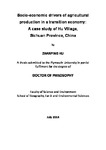Socio-economic drivers of agricultural production in a transition economy: A case study of Hu Village, Sichuan Province, China
| dc.contributor.supervisor | Rahman, Sanzidur | |
| dc.contributor.author | Hu, Zhanping | |
| dc.contributor.other | School of Geography, Earth and Environmental Sciences | en_US |
| dc.date.accessioned | 2014-08-13T08:47:02Z | |
| dc.date.available | 2014-08-13T08:47:02Z | |
| dc.date.issued | 2014 | |
| dc.identifier | 10316899 | en_US |
| dc.identifier.uri | http://hdl.handle.net/10026.1/3079 | |
| dc.description.abstract |
Contemporary global agriculture has been undergoing transition towards different pathways. In developed countries, a shift from productivist agriculture to multifunctional agriculture has begun since the 1980s (Wilson, 2007). In the developing world, agricultural modernisation is still the primary strategy for agricultural development, and driven by urbanisation and industrialisation, deagrarianisation of rural society has been widely identified (Bryceson, 1996; Rigg, 2006a). As the largest developing country in the world, China embarked on market reform three decades ago and has ever since experienced dramatic socio-economic transition towards modernisation, industrialisation and urbanisation. Significant levels of academic attention have focused on empirically identifying economic and policy drivers of Chinese agricultural production from a structuralist standpoint, largely neglecting the agency of smallholders and sociocultural factors. To address the resulting literature gap, this thesis adopts an approach that combines political economy and cultural analysis through an in-depth case study of a rural community in southwest China. A multi-methods approach is used to collect data, including questionnaires, in-depth interviews, focus groups, participant observation and the analysis of secondary data. The results suggest that Chinese smallholder agriculture has been dramatically transformed by an array of socio-economic forces. The “intensive, sustainable, diverse” Chinese smallholder agriculture which Netting (1993) portrayed, has been progressively shifted towards extensive, unsustainable and less diverse pathways. It suggests that the “perfunctory agriculture” performed by Chinese smallholders is the outcome of interactions and negotiations between various political, socio-economic and institutional constraints and farmers’ agency. Another key finding is that moving out of agriculture is becoming the norm in Chinese rural society. Most smallholders show willingness to rent out agricultural land and to enter into a capitalist relationship with employees, rather than primarily being cultivators of their land. Land transfer markets have become increasingly buoyant at the local level, and large-scale capitalist agriculture seems to be the desired future of Chinese smallholder agriculture for both the Chinese government and smallholders. Besides, based on the case of Hu Village, this thesis discusses the convergences and divergences between the road of Chinese agricultural development and that of developed countries and other emerging BRIC economies. Lastly, based on the findings of this research, four policy implications are proposed including sponsoring agricultural mutual aid groups, strengthening agricultural extension services, enhancing farmers’ negotiation power through laws, and initiating comprehensive socio-economic reforms to facilitate farmers’ pursuit of non-farm employments. | en_US |
| dc.language.iso | en | en_US |
| dc.publisher | Plymouth University | en_US |
| dc.subject | Socio-economic drivers | en_US |
| dc.subject | Smallholder agriculture | en_US |
| dc.subject | Transition economy | en_US |
| dc.subject | Agrarian change | en_US |
| dc.subject | China | en_US |
| dc.subject | Rural development | en_US |
| dc.title | Socio-economic drivers of agricultural production in a transition economy: A case study of Hu Village, Sichuan Province, China | en_US |
| dc.type | Thesis | |
| plymouth.version | Full version | en_US |
| dc.identifier.doi | http://dx.doi.org/10.24382/4200 |
Files in this item
This item appears in the following Collection(s)
-
01 Research Theses Main Collection
Research Theses Main


